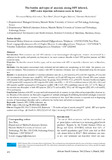The burden and types of anaemia among HIV infected, ART-naive injection substance users in Kenya

Date
2022-04-29Author
Khazalwa, Emmanuel Mulaya
Were, Tom
Mulama, David Hughes
Budambula, Valentine
Metadata
Show full item recordAbstract
ntroduction: Illicit substance use and HIV infection cause haematological derangements. Anaemia characterized by a reduction in the quality and quantity erythrocytes is the most common disorder in both HIV-positive persons and illicit substance users.
Objective: To describe anaemia burden, types, and its association with HIV in injectable substance users in Mombasa, Kenya.
Methods: This descriptive case-control study evaluated red cell indices and morphology in 494 adults. The primary outcome was anaemia. The association of anaemia with HIV in injection substance users was determined using the chi-square test.
Results: The participants included 275 injection substance users (ISU), (HIV-positive, n=62 and HIV-negative, n=213); and 219 non-injection substance users (nonISU), (HIV-positive, n=33 and HIV-negative, n=186). Overall, 49% were anaemic with anaemia burden significantly differing across the groups, Χ2(3, N=494) =12.1, p=0.0070. Anaemia burden was higher in HIV-positive ISU compared to HIV-negative ISU (odds ratio (OR) = 1.59, 95% confidence interval (CI): 0.85, 2.96); and HIV-positive nonISU compared to HIV-negative nonISU (OR = 0.37, 95% confidence interval (CI): 0.17, 0.79). Most of the anaemia was dimorphic in both HIV-positive (ISU, 67% and nonISU, 52%) and HIV-negative (ISU, 43% and nonISU, 55%) participants.
Conclusion: Infection with HIV is associated with increased risk of anaemia in injectable and non-injectable substance users. Majority of the anaemia was dimorphic suggestive of multiple aetiologies. Establishing the related aetiologies is essential for the effective treatment of anaemia. The accurate evaluation of thin blood films remains an essential tool in diagnosing an array of haematologic disorders and as a reference for further tests and patient management.
URI
https://www.ajol.info/index.php/ahs/article/view/224649http://ir-library.mmust.ac.ke:8080/xmlui/handle/123456789/2543
Collections
- Gold Collection [1026]
